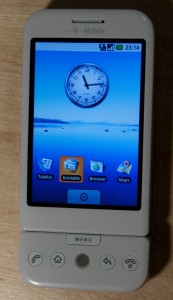
The first Apple iPhone was introduced on January 9, 2007 and went on sale in June 2007. Here’s the original iPhone sitting in it’s charging dock. (Photo: Andrew via Wikimedia Commons)
On Wednesday, January 9, the iPhone turned 6 years old. On that day in 2007 Apple’s late visionary leader Steve Jobs took the stage at the Macworld Expo in San Francisco to address the Apple faithful about a new and highly anticipated product the company was unveiling.
Describing it as a “leap frog product that is way smarter than any mobile device that has ever been and super easy to use,” Jobs introduced the first iPhone to the world.
It wasn’t the very first smartphone – some in the communications industry credit IBM’s Simon Personal Communicator released in 1994 as the first – nor was it the only smartphone on the market at the time – in 2007, Blackberry and Palm devices were all the rage. But the release of Apple’s iPhone really caught the public’s attention and took the smartphone further into the mainstream with its advanced technology and multi-function abilities.
Apple boasted about the capabilities of its new device saying at the time that the iPhone combined three products into one—a new type of mobile phone, a widescreen iPod with touch controls, and an innovative Internet communications device that provided desktop-like email, web browsing, searching and maps.

People wait in line at an Apple Store, in Salt Lake City Utah, to be among the first to get their hands on the new iPhone 5 on Sept. 21, 2012. (Photo: AP)
Between its introduction in January and its release in June 2007, excitement took hold with the iPhone quickly becoming the “must have” device weeks before it even was put on sale. The iPhone became an instant hit with consumers selling over a million devices within its first 74 days on the market, according to Apple.
In the years since, Apple has released newer versions of the iPhone that gave its users even more functionality. One of the most popular new features included the 2011 introduction of “Siri” in its iPhone 4S. Apple described Siri as “an intelligent assistant that helps you get things done just by asking.” Siri interacts and communicates with the user through normal speech: a user just asks Siri a question and “she” answers back via a synthesized voice.

The first smartphone powered by the Android system was the HTC Dream that first went on sale in October 2008 (Photo: Marcus Sümnick via Wikimedia Commons)
While Apple has sold millions of iPhones over the years, the popular smartphone has not been without its critics. For example, when it was first released in the US, Apple had an exclusive agreement with AT & T wireless, meaning the much coveted iPhone could only work on the AT & T wireless system. This arrangement didn’t sit too well with a lot of US consumers, saying it severely limited their choice of wireless carriers to just one. Other complaints about the iPhone since its initial release have included various difficulties that users had in operating the device or about a number of glitches or problems with issues such as software updates or the phones themselves.
As with any successful product, it didn’t take long until Apple competitors like Samsung, HTC, LG and others quickly sprang into action to develop and release their own advanced mobile devices they hoped would dethrone the iPhone as the most popular smartphone.
Despite the release of several imitators, Apple’s iPhone continued its reign as the top smartphone. But dark clouds were forming in the horizon for Apple as word of a new mobile phone operating system began to spread. The web-search engine giant Google had been talking about getting into the mobile telecommunications market since its 2005 acquisition of Android, Inc.; the company that designed and developed the new mobile device operating system. The buzz on the street at the time indicated that the new Android operating system just might be more advanced and superior to what Apple was running on its iPhone.

The popular Android powered Samsung Galaxy S III smartphone. (Photo: Superzen via Wikimedia Commons)
The Android operating system was unveiled in November 2007; just five months after the first iPhones went on sale. The first mobile phone powered by the Android system, the HTC Dream, was released in October 2008.
Google offered the Android system with an open source code and a somewhat lenient licensing arrangement, making it much easier for software that would run on the Android system to be written, modified and distributed.
So far, according to recent research statistics, about 700,000 software applications or “apps” have been developed for mobile devices running on the Android system. But, Apple continues to lead Android with a reported 1,000,000 apps developed for the iPhone.
The Android powered Samsung Galaxy S III and Apple’s iPhone 4S are two of the most popular smartphones being sold today.
The fight for market domination among smartphone manufacturers continues to fuel research and development of even much more advanced and sophisticated mobile devices.





















Comments are closed.